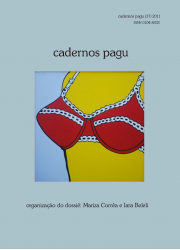Resumo
A guerra na Bósnia-Herzegóvina organizou territórios etnicamente e redefiniu as categorias étnico-nacionais – sérvia, croata e bosniac (muçulmana). Enquanto os soldados combatiam nas linhas de frente, inúmeras eram as atrocidades testemunhadas em outros campos de batalha: casas, vilas, cidades, campos de detenção e concentração e os campos de estupro. Faço neste artigo uma revisão da discussão acerca do estupro na guerra na Bósnia, como este pode ser visto como arma de guerra e um instrumento de limpeza étnica e de tentativa de extermínio.
Abstract
The war in Bosnia and Herzegovina ethnically organized territories and redefined the ethno-national categories and groups – Serbs, Croats and Bosnians (Muslims). Beside the battles between soldiers at the front lines, several atrocities used to happen in other fields: homes, villages, cities, detention places, concentration camps, and the rape camps. This article introduces the debate about the rapes that occurred during the war in Bosnia and the ways to understand them: as a war weapon, as an ethnic cleansing tool, as an attempt to extermination.
Key Words: Bosnia and Herzegovina, Rape, Ethnic Cleansing, Nationalism, Gender
Referências
ARNAUT, Meldijana. Silovanje: zločin koji se ćuti. Sarajevo, s.n., s.d..
Artigo cedido pela autora. [Estupro: o crime que se silencia].
BASSIOUNI, M. Cherif. (coord.) Annex IX. Rape and sexual assault. United Nations - Security Council. S/1994/674/Add.2 (Vol. V). 28 Dec. 1994.
Final report of the United Nations Commission of Experts established pursuant to security council resolution 780 (1992).
[http://www.ess.uwe.ac.uk/comexpert/ANX/IX.htm – Acesso em 30/jul./2011].
BANJEGLAV, Tamara. Gender, Nation, Rape: Intersections of Gender and Ethnic Violence during the War in Bosnia and Herzegovina.
Submitted to Nationalism Studies Program, Central European University, Budapest, Hungary, 2009. In partial fulfillment of the requirements for the degree of Masters of Arts.
BOUGAREL, Xavier; HELMS, Elissa; DUIJZINGS, Ger. (eds.) Introduction.
The new Bosnian mosaic: identities, memories and moral claims in a post-war society. Hampshire, Ashgate, 2007, pp.1-35.
BOURDIEU, Pierre. Les sens pratique. Paris, Les Éditions de Minuit, 1980.
BRINGA, Tone. Being Muslim the Bosnian way: identity and community in a Central Bosnian village. Princeton, Princeton University Press, 1995.
BROWNMILLER, Susan. Against our will: men, women and rape. New York, NY, Fawcett Columbine, 1993.
CAHILL, Ann J. Rethinking rape. Ithaka, NY, Cornell University, 2001.
CLEIREN, Christine P.M. (coord.) Annex II. Rape and sexual assault: a legal study. Final report of the United Nations Commission of Experts established pursuant to security council resolution 780 (1992).
S/1994/674/Add.2 (Vol. I). 28 Dec. 1994.
[http://www.ess.uwe.ac.uk/comexpert/ANX/II.htm – Acesso em: 30/jul./2011].
DAS, Veena. Life and words: violence and the descent into the ordinary.
Berkeley, University of California, 2007.
__________. Fronteiras, violência e o trabalho do tempo: alguns temas wittgensteinianos. Revista Brasileira de Ciências Sociais, vol. 14, nº 40, São Paulo, jun. 1999, pp.31-42.
__________. Critical events: an anthropological perspective on contemporary India. New Delhi, Oxford University Press, 1995.
HAYDEN, Robert M. Rape and Rape Avoidance in Ethno-National Conflicts: Sexual Violence in Liminalized States. American Anthropologist, New Series, vol. 102, nº 1, Mar. 2000, pp.27-41.
__________. Imagined Communities and Real Victims: SelfDetermination and Ethnic Cleansing in Yugoslavia. American Ethnologist, vol. 23, nº 4, nov. 1996a, pp.783-801.
__________. Schindler's Fate: Genocide, Ethnic Cleansing, and Population Transfers. Slavic Review, vol. 55, nº 4, Winter 1996b, pp.727-748.
KESIĆ, Vesna. Muslim women, Croatian women Serbian women, Albanian women. In: BJELIĆ, Dušan I.; SAVIĆ, Obrad. (eds.) Balkan as metaphor: between globalization and fragmentation. Cambridge, Mass., MIT Press, 2002, pp.311-321.
NACIONALNI sastav stanovništva: rezultati za republiku po opštinama i naseljenim mjestima 1991. Popis stanovništva, domaćinstava, stanova i polioprivrednih gazdinstava 1991. Sarajevo, Drţavni zavod za statistiku Republike Bosne i Hercegovine, dec./pros. 1993.
(http://www.fzs.ba/Dem/Popis/nacionalni%20sastav%20stanovnistva %20po%20naseljenim%20mjestima%20bilten%20234.pdf – Acesso em: 03/set./2011). [Composição nacional dos habitantes: resultado para a república por municipalidades e localidades 1991. Censo de habitantes, habitações (apartamentos e casas) e propriedades agrícolas 1991] NAHOUM-GRAPPE, Véronique. The anthropology of extreme violence: the crime of desecration. International Social Science Journal, Unesco, vol. 54, nº 174, Dec. 2002, pp.549-557.
PERES, Andréa Carolina Schvartz. Contando histórias: fixers em Sarajevo.
Tese de Doutorado em Antropologia Social. Universidade Estadual de Campinas, Campinas, 2010.
PÉREZ, Natália Rodríguez. “Quem me torturou não foi Karadzic”. O Estado de S. Paulo, São Paulo, 27 jul. 2008, Internacional.
STIGLMAYER, Alessandra. The rapes in Bosnia-Herzegovina. In: STIGLMAYER, Alessandra. (ed.) Mass rape: the war against women in Bosnia-Herzegovina. Lincoln and London, University of Nebraska, 1994, pp.82-169.
STOLCKE, Verena. Pluralizar o universal: guerra e paz na obra de Hannah Arendt. Mana, vol. 8, nº 1, Rio de Janeiro, 2002, pp. 93-112.
ŢENA - ŢRTVA RATA. O nama. 2010. Disponível em: .
Acesso em: 30/jul./2011. [Mulheres - Vítimas da Guerra.
Sobre nós.] VULLIAMY, Ed. Seasons in hell: understanding Bosnia's war. New York, NY, St. Martin's Press, 1994

